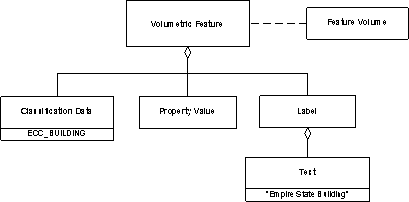The SEDRIS Data Representation Model
APPENDIX A - Classes
Feature Volume
|
|---|
Class Name: Feature Volume
Subclasses
This DRM class is concrete and has no subclasses.
Definition
An instance of this DRM class is a 3-dimensional
<Feature Topology> instance used to
represent the region of space that corresponds to parts of
zero or more <Volumetric Feature>
instances, bounded by two or more
<Feature Face> instances.
Primary Page in DRM Diagram:
Secondary Pages in DRM Diagram:
Example
Consider a <Volumetric Feature>
representing a building. It has an associated
<Feature Volume>, which
defines its extent, shape, and topological relationships;
a <Classification Data> component
that classifies it as an ECC_BUILDING;
<Property Value> components that
describe its characteristics, such as material composition, and a
<Label> that identifies it as
"The Empire State Building".

FAQs
- When are <Feature Volume>
instances required?
<Feature Volume> instances are
required whenever there are
<Volumetric Feature>
instances, regardless of the feature topology level.
- Are there any geometric constraints on
<Feature Volume> instances?
Yes. <Feature Volume> instances
must always have closed external boundaries, and their
interiors must be fully connected. At feature topology
level 5, the interiors of
<Feature Volume> instances may
not intersect or overlap one another, and
<Feature Volume> instances may
meet only along one or more common
<Feature Face> instances.
- Can <Feature Volume> instances
exist at any feature topology level?
Yes. <Feature Volume> instances
may exist at any feature topology level in order to define
the extents of <Volumetric Feature>
instances. At feature topology level 5, the collection of
<Feature Volume> instances must
exhaustively and exclusively partition the 3-dimensional
topological space, such that exactly two
<Feature Volume> instances
shall be bounded by each <Feature Face>.
- Looking at the relationships allowed for
<Feature Topology>, we
note that the <Feature Node> to
<Feature Node> association, and
the <Feature Edge> to
<Feature Edge> association are "many to
many", while the <Feature Face>
to <Feature Face> association is
"optional to optional". Why is there no corresponding
association between <Feature Volume>
instances?
These associations exist to support cross-tile topology. This
refers to topological relationships that cross multiple branches
below a
<Spatial Index
Related Features>,
<Spatial Index
Related Feature Topology>,
<Perimeter Related
Features>, or
<Perimeter
Related Feature Topology> instance.
<Feature Node>,
<Feature Edge>, and, in 3D,
<Feature Face> instances can be
located on the boundary of a tile. When this happens, they have
"counterparts" in each of the adjacent tiles that share the
boundary. These associations allow
<Feature Node>,
<Feature Edge>, and
<Feature Face> instances to identify their
counterparts, if any.
In 2D,
- tile boundary <Feature Node>
instances come in pairs, unless they're located at a
corner where four tiles meet,
- tile boundary <Feature Edge>
instances always come in pairs,
- <Feature Face> instances are
always contained within a single tile.
In 3D,
Constraints
Associated by (one-way)
Associated with (two-way)
Composed of (two-way) (inherited)
Composed of (two-way)
Component of (two-way) (inherited)
Inherited Field Elements
This class has no inherited field elements.
Notes
Associated from Notes
The <Feature Face> instances that border a given <Feature Volume>
instance indicate the relationship by their association to the
<Feature Volume> instance. The converse of this relationship is
that between <Feature Volume Shell> and <Feature Face>.
Associated with Notes
If a given <Feature Volume> has an association relationship
with a <Feature Edge> instance, that <Feature Edge>
instance is contained within the <Feature Volume>.
If a given <Feature Volume> has an association relationship
with a <Feature Node> instance, that <Feature Node>
instance is contained within the <Feature Volume>.
Composed of Notes
The first <Feature Volume Shell> instance associated with a
<Feature Volume> instance is its external shell, while the
remaining, if any, are its internal shells.
Exception: Since the universal <Feature Volume> has
no external boundary, all of its shells are internal shells. The
universal <Feature Volume> can be identified by the fact that its
universal field is set to SE_TRUE.
Prev: Feature Topology Hierarchy.
Next: Feature Volume Shell.
Up:Index.
|
Last updated: July 16, 2004
|
Copyright © 2004 SEDRIS™
|
|
